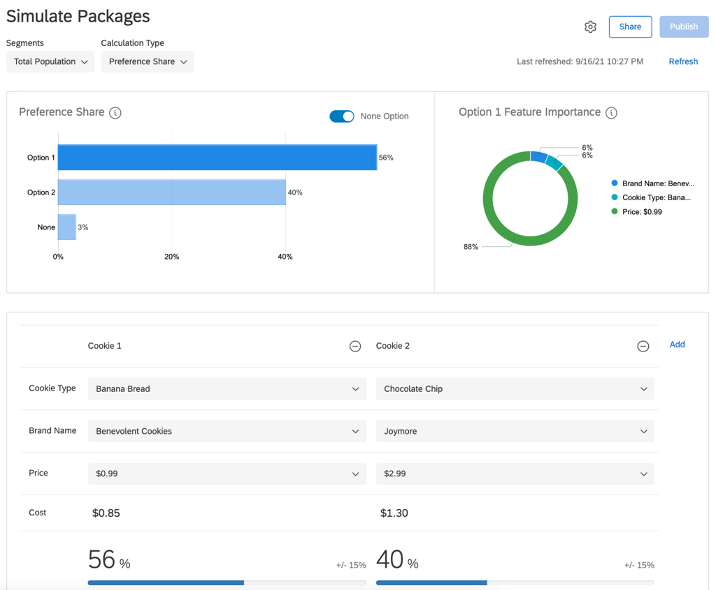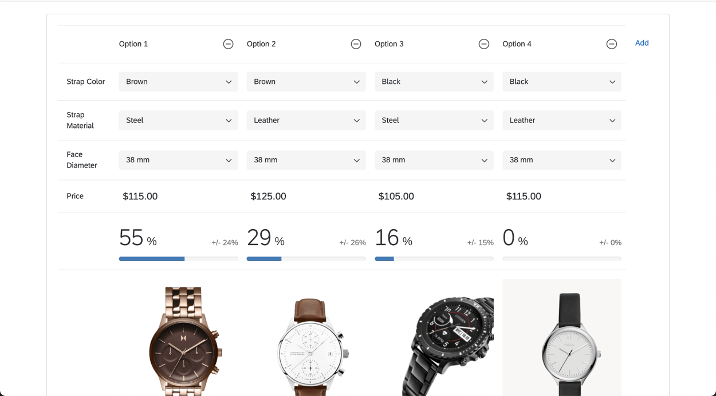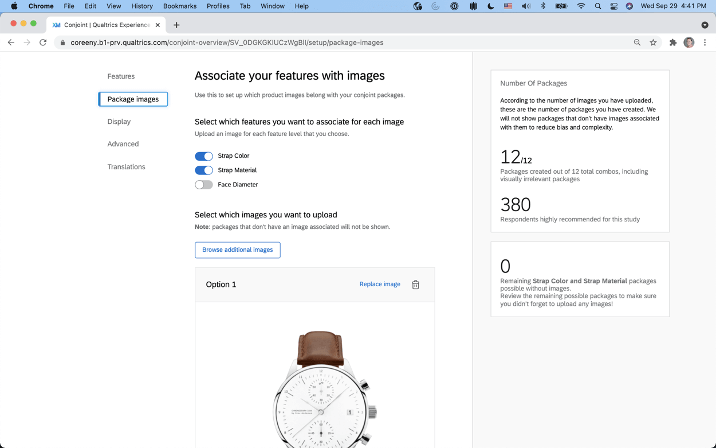
Experience Management
Advanced Research Made Easy – Conjoint Analysis
What is conjoint analysis and how can you use it to enhance the value of the products and services you provide to customers? Read on to learn more about how conjoint analysis works, why you should use it to ensure product and service success, and what we can do to support your efforts.
Designing great experiences starts with understanding your customers
Here at Qualtrics, we always talk about designing new experiences for your customers. That experience could be a product, service, or an offering that really stands out and creates differentiated value for end consumers.
But as more and more organizations embrace experience design, they need a firm understanding of the value their products bring to customers. An area where this is acutely important is packaging and pricing. As organizations develop multiple products with a varied number of features, it is critical for them to land the right combination of features in each product to provide an optimal experience as well as maximize their own business metrics.
This is where conjoint analysis comes in.
What is conjoint analysis?
Conjoint analysis is a form of statistical analysis that enables you to determine what product features and attributes, services or offerings are important to your target customers, helping optimize your chances for success in that market.
A conjoint analysis example (more on this later) could be a television manufacturer wanting to know if customers value sound over picture quality.
It is based on the principle that any product can be broken down into a set of attributes that ultimately impact users’ perceived value of that item. This mathematics-based market research method helps to uncover the trade-offs that customers would make by forcing them to select product configurations they prefer. The output is used to model market adoption, competitive analysis, and optimal product packaging.
How can you use conjoint analysis?
An organization could use conjoint to answer important business questions like:
- How can we create differentiated freemium and paid editions by understanding the monetary or relative value of each of the features to the market?
- How can we design ideal packages of services or offerings?
- What role does price play in decision making, and what are the pricing sweet spots?
- What R&D priorities for specific features should we focus on?
- How do the products we are considering compare to the competition? What can we do to best compete against what is currently on the market?
What methods are available to conduct conjoint analysis?
Conjoint analysis employs several different types of conjoint analysis techniques, each one having its own specific application. These include:
- Menu-based conjoint analysis:
helps to determine the right combination of product features and services when a degree of customization is required - Two-attribute trade-off analysis:
attribute by attribute, respondents rank their preferences for product features and services based on combinations of attribute levels - Full-profile conjoint analysis:
displays a large number of full product descriptions to the respondent - Adaptive conjoint analysis:
varies the choice sets presented to the respondents based on their preference - Choice-based conjoint analysis:
requires the respondent to choose their most-preferred full-profile concept - Self-explicated conjoint analysis:
a hybrid approach that focuses on evaluating various attributes of a product - Max-diff conjoint analysis:
presents an assortment of packages to be selected under best/most preferred and worst/least preferred scenarios - Hierarchical Bayes analysis (HB):
estimate attribute level utilities from choice data
Learn more about these types here.
According to Harvard Business School professor Clayton Christensen, 95% of new products fail.
We’ve all heard and seen the statistics for product success, and it’s an uphill battle to produce products that resonate.
Because of this, product teams should arm themselves with every tool they can to improve their odds. This is why conjoint analysis has gained significant steam over the last decade and is now a must-have solution for developing products.
What are the benefits of conjoint analysis?
A prime reason why conjoint analysis is a go-to-market research methodology is because of the highly relevant nature of the insights gathered. The trade-off scenarios we place before the respondents are similar to real world experiences we all face every day.
Think about the data we would receive if we asked each respondent how much they like a flight package that includes coach seats with no layover for $400? A ‘6 out of 7’ isn’t all that helpful when we are trying to measure the opportunity. Is my 6 the same as your 6?
A better method would be to test that flight option versus a different configuration and ask which one is more preferred. Conjoint analysis implements a discrete choice approach where there is nothing arbitrary about the response. This allows the insights to be extremely actionable.
Conjoint analysis example #1
Let's say you want to measure individual features of a product and estimate how they affect market share or sales revenue. For the purposes of this example, the product in question is a mobile phone.
You would need to understand how customers value attributes such as brand, price, screen size, resolution, performance, and other factors versus the competition.
Conjoint analysis enables you to assign values to each of these attributes by creating realistic choices and asking customers to evaluate them. You can then understand consumer preferences for features, pricing, and more.
Conjoint analysis example #2
A software company might want to change its pricing strategy and provide a freemium model. Through conjoint analysis, the company could determine which features are most valuable and hide those behind a paywall. The remaining features remain in the freemium version of the product. This helps them to determine a customer's willingness to pay for certain features. The company could go a step further and look at specific market segments to further understand consumer preferences for product features.
Why use Qualtrics for Conjoint analysis?
Qualtrics is a best-in-class technology solution for running conjoint analysis projects (like conjoint surveys). Featuring an easy-to-use interface that walks users from start to finish, it enables teams to quickly understand the potential of different product configurations.
Our conjoint analysis software places some of the more scary statistical elements (such as generating the packages to review, modeling respondents' preferences, simulating potential outcomes, and more) behind the scenes, enabling users to focus on defining product attributes, refining entire surveys, and analyzing the results.

With the recently announced “Conjoint Dynamic Images”, you can use the imagery in place of text-based attributes in your conjoint studies. This allows you to test visual attributes of a package or product to determine the winning combination that customers are most likely to consider leads to the highest likelihood to consider. Additionally, by using images as a replacement for multiple text-based attributes, you can get the same data from customers with less survey fatigue.
If a picture is worth a thousand words, Conjoint Dynamic images can speak volumes. And, using software like Qualtrics, you can leverage a superior conjoint analysis technique to bring the results your business needs.


Further reading: Conjoint Analysis White Paper
You can also book a demo and speak to our experts if you want to explore the software further or have a specific conjoint study you’d like to see.
Discover how you can optimize your business with conjoint Analysis